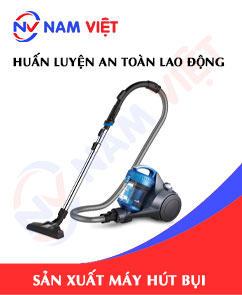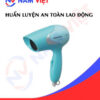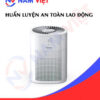Occupational Safety Training in Vacuum Cleaner Manufacturing
99,000 ₫
Note: The above price is calculated for one person, the price may fluctuate depending on the number of trainees participating in the course and depending on market movements. For more accurate pricing support, please refer to the quotation table or contact our consulting staff directly.
Occupational safety is an important issue in vacuum cleaner manufacturing factories and needs to be addressed promptly to ensure the health and safety of workers, and to enhance the reputation of businesses. The Occupational safety training course is one of the effective solutions to raise awareness about accident prevention for workers participating in vacuum cleaner manufacturing.
Table of Contents
Toggle1. Overview of Vacuum Cleaners
a. What is a vacuum cleaner?
A vacuum cleaner (also known as a dirt vacuum) is a household electrical device used to suction and remove dust, debris, and other particles from floors, carpets, or other surfaces in the home. Vacuum cleaners operate by generating a strong airflow, creating pressure that draws dust, debris, and small particles into a filter inside the machine. Modern vacuum cleaners come with a variety of features and designs, ranging from conventional vacuum cleaners to automated robotic vacuum cleaners.

b. Types of machinery used in vacuum cleaner production
The production and assembly process of vacuum cleaners involves multiple stages and typically uses the following types of machinery:
- Metal cutting and processing machines: used to cut and process metal parts such as pipes, sheets, and frames.
- Plastic molding machines: used to manufacture plastic parts of the vacuum cleaner, such as the body, handle, dust container cover, and other small components.
- Packaging machines: used to package parts and components after production and quality inspection.
- Assembly machines: used to assemble components and parts into the complete product, including the suction system, filters, and motor.
- Testing and inspection machines: used to check the quality of vacuum cleaners to ensure the products meet technical standards and are safe for users.
- Packing and transport machines: used to package finished products and prepare them for delivery to stores, distributors, or end customers.
These machines are controlled and monitored by computers and production management software to ensure that the production and assembly processes follow the correct procedures and that the product quality meets technical and safety standards for users.

c. Vacuum cleaner manufacturers in Vietnam
In Vietnam, there are several well-known vacuum cleaner brands, including:
- Lock&Lock: A brand from South Korea, specializing in household products, including vacuum cleaners. Lock&Lock products are diverse in design and power, capable of efficiently suctioning dust, sand, pet hair, and small particles.
- Electrolux: A brand from Sweden, specializing in household products, including vacuum cleaners. Electrolux is recognized for high-quality products with durability and stable performance.
- Philips: A brand from the Netherlands, also specializing in household products, including vacuum cleaners. Philips vacuum cleaners feature modern design, convenience, and energy efficiency.
- LG: A brand from South Korea, producing electronics and household products, including vacuum cleaners. LG vacuum cleaners are equipped with smart features, operating quietly and efficiently.
- Panasonic: A brand from Japan, producing electronics and household products, including vacuum cleaners. Panasonic vacuum cleaners are equipped with advanced technology, capable of cleaning dust, bacteria, and small airborne particles.
These are some of the well-known vacuum cleaner brands in Vietnam, though there are still other brands with good quality that are highly rated by consumers.
d. Specific jobs in a vacuum cleaner manufacturing plant
Group 1
- Executive director, deputy executive director, and department heads in the vacuum cleaner manufacturing plant.
Group 2
- Safety officers: manage workplace safety, design safety procedures, supervise and ensure employees follow safe working protocols.
Group 3
- Procurement of materials and components: purchasing staff are responsible for sourcing and acquiring the materials and components needed for vacuum cleaner production.
- Component production: factories manufacture necessary components for vacuum cleaners, including motors, filters, wheels, and housings.
- Product assembly: components are assembled into complete products by technical staff. The assembly process includes installing motors, filters, voltage converters, control units, suction bases, etc.
- Quality control: after production and assembly, products are inspected to ensure they meet established quality standards.
- Packing and shipping: products are properly packed and prepared for storage or delivery to end customers.
- Customer service: the factory provides customer support including product instructions, warranty, and repair services if defects or malfunctions occur.
Group 4
- Office, service, sales, and marketing jobs.
- Production management, quality management, human resources management, material management, financial and accounting management.
- Product design and development: engineers and designers conduct research, development, and testing to ensure products meet customer requirements and quality standards.

2. Overview of occupational safety training for vacuum cleaner production
In this article, we focus on issues related to Group 3, because Group 3 is directly involved in the production process and bears the highest occupational safety risks. For other groups, see here.
a. What is Group 3 occupational safety training?
- Group 3 occupational safety training consists of classes that equip workers with knowledge on how to prevent workplace accidents.
- The training course helps workers identify and avoid hazards, reducing the risk of occupational accidents during work.
REGISTER FOR OCCUPATIONAL SAFETY TRAINING
b. Training duration
Initial safety training duration
- Total training duration is at least 24 hours, including examination time.
- 8 hours of theory on safety and labor hygiene policies and laws
- 8 hours of theory on basic occupational safety and hygiene knowledge
- 4 hours of theory on specialized training content
- 2 hours of practical training on specialized content
- 2 hours of theoretical examination at the end of the course
The safety training center will divide the time into multiple sessions depending on the schedule of workers. Typically, there are 6 training sessions over 3 days, provided the manufacturing company can arrange continuous training time.
Periodic safety training duration
- Before the occupational safety card expires, workers seeking renewal must undergo periodic occupational safety training, with periodic training duration at least 50% of the initial training duration.
Explanation: total periodic occupational safety training duration is at least 12 hours, including examination time. Upon completion of the periodic training and passing the test, the worker will be reissued and renewed for the occupational safety card.
c. Training content
| No. | TRAINING CONTENT | TRAINING DURATION (HOURS) | |||
| Total | Including | ||||
| Theory | Practical | Examination | |||
| I | Policies, laws on occupational safety and hygiene | 8 | 8 | 0 | 0 |
| 1 | Overview of the legal documents system on occupational safety and hygiene. | 6 | 6 | ||
| 2 | System of safety and hygiene technical standards and regulations. | 1 | 1 | ||
| 3 | Specific regulations of state management agencies regarding occupational safety and hygiene when constructing, expanding, or renovating production facilities, and handling machines, equipment, materials, or substances with strict safety and hygiene requirements. | 1 | 1 | ||
| II | Basic knowledge of occupational safety and hygiene | 8 | 8 | 0 | 0 |
| 1 | Basic knowledge of hazardous and harmful factors in the workplace. | 4 | 4 | ||
| 2 | Methods to improve working conditions. | 1 | 1 | ||
| 3 | Safety culture in production and business. | 1 | 1 | ||
| 4 | Rights and obligations of employers and employees; safety and hygiene policies for employees; roles and responsibilities of safety officers. | 1 | 1 | ||
| 5 | Occupational safety rules, signage, safety instructions, use of safety equipment, personal protective equipment, first aid skills, and occupational disease prevention. | 1 | 1 | ||
| III | Specialized training content | 6 | 4 | 2 | 0 |
| Comprehensive knowledge of machines, equipment, and substances generating hazardous or harmful factors; risk analysis, assessment, management of occupational safety and hygiene; safe work procedures with machines, equipment, and substances with strict safety and hygiene requirements. | 6 | 4 | 2 | ||
| IV | Final occupational safety training examination | 2 | 2 | 0 | 0 |
| Total | 24 | 22 | 2 | ||
See more training content of the 6 groups
d. Occupational safety card
After completing occupational safety training and passing the examination, workers will be issued an occupational safety card (commonly referred to as a Group 3 safety certificate).
The Group 3 safety card clearly shows information such as full name, date of birth, job, and specific working environment, along with training duration, red stamp, and signature confirming course completion.
According to the regulations stated in Clause 2 of Article 24, Decree 44/2016/ND-CP, there are two cases:
- If the employer and employee have an employment contract, the employer must sign, stamp, and endorse the occupational safety card for Group 3 trainees after completing training from the safety training unit and passing the examination.
- If the worker is freelance or seasonal, without an employment contract, the training unit must sign, stamp, and endorse the card after the worker completes the training and passes the examination.

3. Identifying Hazards Affecting Workers in Vacuum Cleaner Production
The vacuum cleaner production process may contain some potential hazards for workers, such as:
- Risk of burns or explosions: During production, workers often come into contact with liquids, gases, or flammable and molten materials, which may lead to burns or explosions.
- Risk of accidents during transportation and assembly: For large equipment, transportation and assembly may cause risks of impacts, drops, pulls, and injuries to workers.
- Risk of chemical poisoning: In the production process, workers often come into contact with hazardous chemicals. Improper use may harm their health.
- Risk from noise exposure: Vacuum cleaner production often involves high noise levels from equipment, and continuous noise exposure can damage workers’ hearing.
- Risk from dust and fine particles: Workers may suffer respiratory damage or pneumonia due to exposure to dust and fine particles during production.
- Electrical hazards: If electrical equipment in the factory is not regularly maintained or properly insulated and waterproofed, it can cause electric shocks to workers during production.
4. Common Workplace Accidents for Workers in Vacuum Cleaner Production
Common workplace accidents during vacuum cleaner production include:
- Improper use of equipment or machinery, leading to serious workplace accidents such as machinery accidents, complete loss of products, or fatalities.
- Cuts or punctures from using cutting, grinding, drilling, or planing tools during assembly of vacuum cleaner components.
- Chemical poisoning from direct contact or inhalation of chemicals during production.
- Falls or slips while handling, moving, or installing vacuum cleaner components.
- Burns from contact with hot materials during production.
- Injuries caused by heavy or bulky materials when lifting, pulling, or handling vacuum cleaner components.

5. Safety Measures for Participating in Vacuum Cleaner Production
To ensure worker safety during vacuum cleaner production, the following safety measures should be applied:
- Use of personal protective equipment: Staff must be provided with full personal protective equipment such as gas masks, gloves, safety glasses, anti-slip shoes, etc.
- Occupational safety training: Staff are trained on how to safely and effectively operate vacuum cleaners, and how to prevent workplace accidents.
- Regular supervision and maintenance: Machinery and equipment should be regularly inspected and maintained to ensure proper operation and avoid hazards to users.
- Safety design: Machinery, equipment, and production systems should be designed to ensure worker safety and prevent workplace accidents.
- Periodic product quality inspection: Regular inspections ensure products meet safety and quality standards, minimizing accidents caused by defective products.
- Strict safety management: Safety management is critical in vacuum cleaner production. Regulations on occupational safety, material handling, and waste management must be strictly followed to ensure worker and environmental safety.
- Periodic workplace environment monitoring in factories to collect and analyze harmful factors affecting workers, thereby adjusting to reduce hazards and prevent occupational diseases.
6. Benefits of Occupational Safety Training for Vacuum Cleaner Production
An Toan Nam Viet provides businesses with the following benefits after completing occupational safety training courses as regulated under Decree 44/2016/ND-CP on occupational safety and hygiene for companies and enterprises:
- Workers can identify potential workplace hazards and take preventive measures to avoid accidents.
- Businesses can establish risk prevention measures in production, operation, and maintenance processes.
- Minimize costs associated with safety risks in labor.
- Uninterrupted production increases labor productivity and product quality.
- Compliance with occupational safety regulations reduces legal risks.
- Enhances professionalism and reputation, thereby elevating the brand of the business.
Nam Viet’s training courses are solutions to prevent external factors from affecting individuals, helping them avoid dangers that may lead to injury or even death.
REGISTER FOR OCCUPATIONAL SAFETY TRAINING
7. Customer Feedback After Completing Occupational Safety Training for Vacuum Cleaner Production
An Toan Nam Viet has many years of experience accompanying enterprises in Vietnam in general, and in the southern provinces in particular. This responsibility is extremely valuable for Nam Viet, which is why our occupational safety training is increasingly professional. The motivation for Nam Viet’s growth comes from positive feedback and suggestions from enterprises. Below are feedbacks from our partners:
Bac Nam E&C Investment and Construction Joint Stock Company
“My first experience using An Toan Nam Viet’s services surprised me with the 24/7 enthusiastic support from the consulting team. Class organization was quick and convenient for our company. Thank you very much for Nam Viet’s service!”
Hoa Dat Construction and Trading Joint Stock Company
“Nam Viet’s services greatly helped us simplify occupational safety and complete safety documentation for the work process. The consulting team was enthusiastic and timely in addressing our questions. 5 stars for Nam Viet.”
See more customer interviews after using the services of An Toan Nam Viet
8. An Toan Nam Viet’s Capacity in Occupational Safety Training
An Toan Nam Viet is a reputable and high-quality occupational safety training center in Vietnam. Our safety training sessions are continuously conducted at production workshops, factories, and construction sites across the country (all 63 provinces of Vietnam).
REGISTER FOR OCCUPATIONAL SAFETY TRAINING
Occupational Safety Training License
- An Toan Nam Viet has been inspected and certified by the Department of Safety under the Ministry of Labor, War Invalids and Social Affairs and granted a certificate of eligibility for occupational safety and hygiene training. This further strengthens our capacity in occupational safety training.

Documents and Lectures
- Before being included in occupational safety training courses, all materials are reviewed to ensure the lectures are accurate and effective.
- Instructors’ teaching methods follow An Toan Nam Viet standards, developed by experts in occupational safety and hygiene training to ensure optimal knowledge absorption by learners.
Facilities
- Controlling classroom factors affecting training enhances teaching efficiency and knowledge retention.
- Our training facilities provide spacious classrooms meeting standards for area, lighting, and training equipment.
9. Nationwide Reputable Safety Training Center
At An Toan Nam Viet, occupational safety training is our top priority. Providing workers with knowledge to protect themselves contributes to national development.
To ensure effective training, we meticulously prepare every detail, from tools and equipment to curriculum, materials, audio, and lighting.
Our instructors are experienced experts, with research on hazard identification in all industries and prevention methods.
Lectures are practical and presented in an engaging, understandable way, helping workers comfortably learn and absorb knowledge. Content always aligns with Decree 44/2016/ND-CP.
Workers learn hazard prevention and self-protection, applying it appropriately in real work situations.
Our training center proudly provides professional occupational safety training services with the following advantages:
- Competitive training costs without compromising quality.
- Flexible training schedule based on company production.
- Quick and legal certification procedures for occupational safety training.
- Experienced instructors with many years in the field.
- Classrooms are controlled to maximize teaching efficiency and knowledge retention.
- Lectures tailored to occupational safety in enterprises.
- Dedicated, professional support ensuring timely assistance for customers.

10. Additional References for Occupational Safety Training in Vacuum Cleaner Production
- Occupational safety materials for vacuum cleaner production
- Occupational safety training material set
- Occupational safety training test set
- Vacuum Cleaner Production Occupational Safety Training Curriculum
- Vacuum Cleaner Production Occupational Safety Quiz
1 review for Occupational Safety Training in Vacuum Cleaner Manufacturing
No comments yet















namchinh.haiphong341
Dịch vụ huấn luyện an toàn lao động rất tốt nhé!